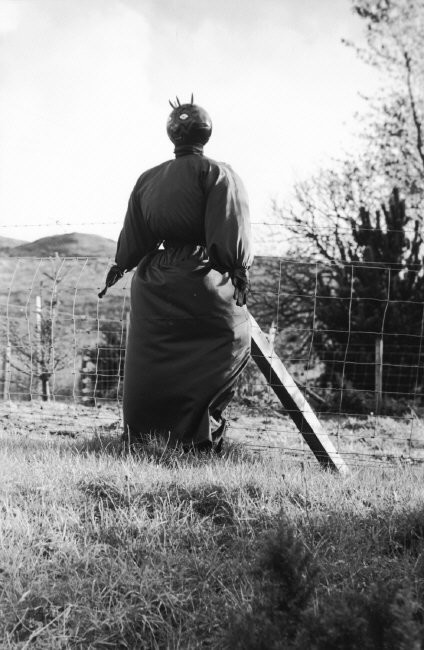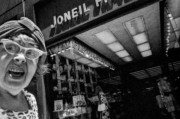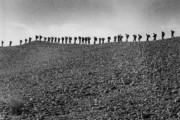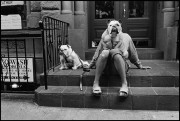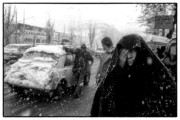Elliott Erwitt’s Scotland
In typical fashion the Magnum photographer has turned his humorous eye upon the country, capturing the grit, beauty, and daily reality of a nation
Famed for his unique and witty photographic vision as well as his wry observations on life and art, Elliott Erwitt, over recent years turned his lens upon Scotland. Like many places, Scotland’s visual identity has often been reduced to stereotype or cliche, yet Erwitt – as those familiar with his work might have expected – saw more than the traditional sweeping views of lochs, or the kilt-wearing bagpipes players. He captured the warmth and humanity of the place and its people, and the sometimes less-than-picturesque reality of it’s cities, as well as the more the fabled traditions, landscapes and icons of the nation.
Here, to mark both Burns Night – the birthday of Romantic Scots poet Robert Burns – and the release of Erwitt’s new book, Scotland, we reproduce the title’s introductory essay by Alexander McCall Smith alongside a selection of the work.
Signed copies of Scotland, published by teNeues, are now available on the Magnum shop.
One of the concomitants of being Scottish is that you encounter, when you travel abroad, a certain misty-eyed romanticism about your country. The romantic idea of Scotland has at least some of its roots in the great Ossian saga of James Macpherson and the historical novels of Sir Walter Scott. These two writers, in their rather different ways, appealed to a European imagination eager to find a country where stirring deeds were performed against a backdrop of mountains, waterfalls, and remote glens. That Scotland, the land of the mountain and the flood, has never altogether gone away and today still influences the way people think about this small but quite vocal country on the very edge of Europe.
For some, that romantic vision of Scotland is an anathema. For these critics, the uncomfortable reality of Scotland is something quite different; it is the industrialised terrain of the Central Belt, the waist of the country between Edinburgh and Glasgow, that grey landscape of urban sprawl, of defeated villages, of bleak farmland. Scotland, they say, should not be defined by its Highland cattle and picturesque croft houses; it is about high-rise towers and mean streets; it is about the human struggle to make a go of life in a cold and damp northern land that has always been late to join the party or, in some cases, not joined it at all.
"A realistic picture of a country should give proper weight to those things that are positive and edifying, those things that are quirkily charming"
- Alexander McCall Smith
Of course, anybody who lives in Scotland recognizes that dystopia. Yet should we be in thrall to it? In my view, every country has dystopian elements but these always are kept in perspective. A realistic picture of a country should give proper weight to those things that are positive and edifying, those things that are quirkily charming; such a portrayal should not dwell unduly on those things that are grim, wrong, or frankly disastrous. It is easy to capture the negative side of life, but the picture one paints in that way is likely to be one-sided and misleading. The hinterland is just as important, and indeed may be more revealing of a country’s character than its cities; after all, it is the countryside that spawned the urban areas, and it is from the rural population that moved to the nascent cities that those cities took their culture and their values. To understand Glasgow, for instance, it helps to understand the world of the numerous Highlanders and Irish migrants who transformed the city in the nineteenth century.
It is for this reason that the character of Scotland, the essence that gives the country its particularity, may be discovered in precisely those places on which Elliott Erwitt has cast his revealing eye. The Scotland that he has uncovered in this magnificent collection of photographs is the country I recognise. These people, caught doing the things that ordinary people do in their day-to-day lives, are the backbone of Scotland; these scenes are the places in which those lives are lived. The fact that these places are so beguiling does not mean that the photographer has yielded to any temptation to portray only the pretty — it simply means that Scotland is, as these photographs suggest, a land of such beauty that it breaks the heart again and again — and often in surprising, unexpected ways.
"The land is like this. That is how it really does feel. That is why it sends that precise chill up the spine. "
- Alexander McCall Smith
Looking through these photographs, one is struck by the photographer’s justly famous sense of humour. It is not a cruel or mocking humour that points him in the direction of those awkward country weddings and dances — it is a celebratory humour, a sympathetic humour that makes us think yes, I’ve been at just such a wedding; yes, I’ve been at a dance like that. What stands out in this collection is Elliott Erwitt’s eye for the oddly poignant; for the moment that might normally go unnoticed but that, when caught by the camera, is somehow laden with meaning. There is a photograph here of a cooper working on a barrel. It is not a particularly striking scene in itself, but it somehow captures everything that needs to be said about that particular skilled trade. A Scottish cooper is likely to be a down-to-earth person who gets into his work in exactly the way this man does. And that photograph then says a great deal about a score of other trades that one might find being quietly practised in all sorts of Scottish corners.
"What stands out in this collection is Elliott Erwitt’s eye for the oddly poignant; for the moment that might normally go unnoticed but that, when caught by the camera, is somehow laden with meaning"
- Alexander McCall Smith
Any visitor to Scotland in the summer — renowned photographer or not — is likely to be drawn to the Highland games that so many Scottish towns take pride in holding. Each year, I go to just such a set of games in the village near my house in the Highlands. And there I see groups of men exactly like the group we see in this collection — those stocky throwers of hammers and cabers who compete with one another at these events. They all look like the men in that picture: that is just how they are. And then, of course, there is the tug-of-war, also pictured here. Those tests of brute strength still take place, to the delight of spectators.
The social divisions of the countryside are not ignored. There are photographs here of those who live in Scots baronial mansions, standing smiling in front of their domains. There are several photographs of country pursuits, including one of a tweedy shooting party enjoying a break in their shoot, while the gamekeeper, in another picture, lays out the tiny carcases of the quarry. It would be easy to imbue such photographs with an obvious message, but the photographer avoids doing that; Mr. Erwitt is too wry an observer to engage in that sort of thing. Nobody in this collection is picked upon by the camera — a sign, I imagine, of his wisdom and experience of the ways of this world.
"In these photographs, one can sense the imminent onset of rain, never far away in Scotland; one can smell the peat smoke; one can feel the texture of the settings in which life is lived"
- Alexander McCall Smith
And everywhere in this collection, either to the foreground or in the background, is the Scottish landscape. There are plenty of photographs of Scotland that depict, in powerful colours, the picture-book beauty of Scotland’s wild places. These photographs, by contrast, bring the full atmospheric power of black-and-white photography to bear on scenes that are difficult to capture directly, so subtle, so allusive is the light in which they are bathed. The land is like this. That is how it really does feel. That is why it sends that precise chill up the spine. In these photographs, one can sense the imminent onset of rain, never far away in Scotland; one can smell the peat smoke; one can feel the texture of the settings in which life is lived.
"Looking at these photographs made me realise why I love this country. It is because it is just like this."
- Alexander McCall Smith
And the people? The boy sitting on the ground in front of the sedentary statue? The man leaning against the outside wall of the bar, cigarette in hand, wearing the knitted cap of the trawlerman? The man playing the guitar in the pub, his head raised to sing the lyrics of some ancient song about poaching or courting, or about simply refusing to be silent? Yes, they are all there. These are exactly the people you will meet in that hinterland of Scotland, that country behind the country, that these evocative and humorous photographs reveal to us
Looking at these photographs made me realise why I love this country. It is because it is just like this.
Alexander McCall Smith is the author of the No. 1 Ladies’ Detective Agency novels and a number of other series (including the 44 Scotland Street books and the Isabel Dalhousie series set in Edinburgh) and multiple standalone books. His works have been translated into more than forty languages and have been best-sellers throughout the world. He lives in Scotland.
© 2018 by Alexander McCall Smith. First published the teNeueus edition of ELLIOTT ERWITT’S SCOTLAND. Used by permission of the author and his agent, Robin Straus Agency, Inc. All rights reserved.

















